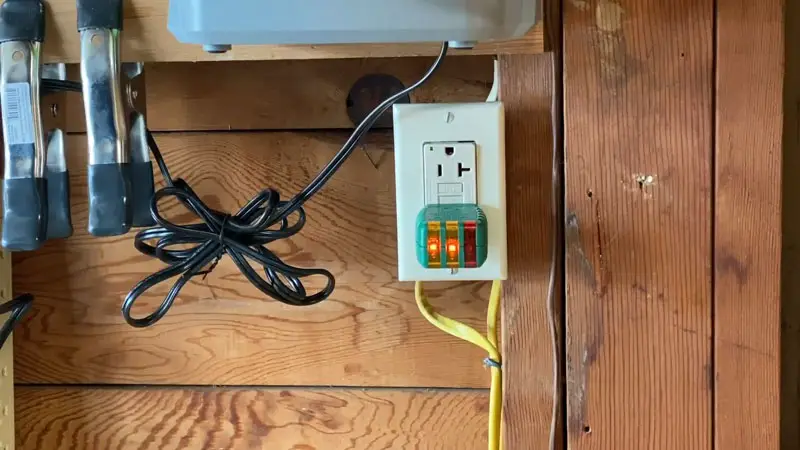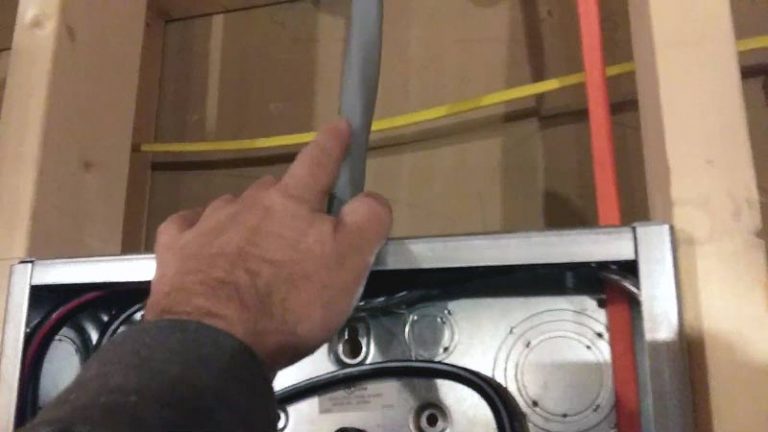What Microwave Cabinet Outlet Do I Need?

Having a functional outlet in the kitchen is essential for powering appliances, chargers, and other devices. Installing a receptacle in the microwave cabinet can not only provide a convenient location for these items, but it can also improve the overall appearance and organization of the kitchen.
In this article, we will discuss the steps and safety considerations for installing a microwave cabinet outlet.
You'll Learn About
Can Any Microwave Be Built Into a Cabinet?
Not all microwaves can be built into a cabinet. Some microwaves are designed to be installed in a cabinet for a built-in look, while others are not. It is important to check the manufacturer’s specifications to see if a particular model can be installed in a cabinet.
In general, built-in microwaves are usually designed to be installed in a cabinet or wall space, with a trim kit that can be used to make the microwave look like it is built into the cabinetry. If a microwave is not designed for this purpose, it may not fit properly or may not have the necessary venting or cooling to function safely.
What Microwave Cabinet Outlet Do I Need?
The kind of outlet you need will depend on the power requirements, circuit breaker, wire gauge, and other features.
Power Requirements
The power requirements for a microwave cabinet outlet will depend on the specific model of the microwave being used. Many standard microwaves require a 20-amp outlet and circuit, while some larger models may require a 30-amp outlet and circuit.
Circuit Breaker or Fuse
The circuit breaker or fuse that is used to protect the outlet and circuit will also depend on the specific power requirements of the microwave. A 20-amp outlet will typically be protected by a 20-amp circuit breaker or fuse, while a 30-amp outlet will be protected by a 30-amp circuit breaker or fuse.
Wire Gauge
The wire gauge used for the circuit will also be determined by the power requirements of the microwave. A 20-amp circuit will typically be served by a 12-gauge wire, while a 30-amp circuit will typically be served by a 10-gauge wire.
Special Features
Some microwaves might have special features that may require additional wiring or outlet types. For example, a convection microwave may require a 240-volt outlet. Some microwaves have built-in exhaust fans which may require additional wiring for ventilation.
Microwave Cabinet Outlet Requirements
| Requirement | 20-amp Microwave | 30-amp Microwave |
|---|---|---|
| Power Requirements | 120 volts, 20 amps | 240 volts, 30 amps |
| Circuit Breaker or Fuse | 20-amp | 30-amp |
| Wire Gauge | 12-gauge | 10-gauge |
| Special Features | None | Built-in exhaust fan or Convection feature |
Note: The specific requirements may vary depending on the model and make of the microwave. It is always best to consult the manufacturer’s specifications for the specific power requirements of the microwave you plan to use.
Things You Need
When installing a microwave cabinet outlet, there are a few things to consider or have on hand to ensure a smooth and successful installation:
Electrical Codes And Regulations
Make sure to familiarize yourself with local electrical codes and regulations to ensure that the installation is done correctly and safely. This may include using the proper type of wire and receptacle, as well as following guidelines for wiring and protection.
Tools and materials
Gather the necessary tools and materials for the installation, such as a hole saw or spade bit, wire connectors, electrical tape, and a metal handy box or recessed old work box.
Power Source
Make sure that you have access to a power source for the receptacle. This may involve switching off the circuit breaker or unplugging an appliance that is connected to the outlet.
Measurements
Measure the dimensions of the cabinet and the cord of your microwave to ensure that you have enough space for the receptacle and that the cord will reach it.
Safety Equipment
Wear protective equipment, such as gloves and safety glasses, when working with electricity. This will help protect you from electrical shocks or injuries.
By considering these things, you can help ensure that the installation process goes smoothly and that the final result is functional and safe.
How To Installing A Microwave Cabinet Outlet
If you want to install a receptacle in the cabinet above your microwave, it is important to follow proper electrical codes and safety guidelines to ensure that the installation is done correctly. Here are some steps you can follow:
Determine The Location For The Receptacle
The receptacle should be located at a height that is convenient for use and allows enough clearance for the cord of your microwave. Consider the placement of the microwave and other appliances in the area to find the most suitable location.
Cut A Hole In The Back Of The Cabinet
Use a hole saw or spade bit to bore a hole through the back of the cabinet that is large enough for the receptacle and wire to fit through. Be careful not to damage the surrounding cabinet or drywall when cutting the hole.
Install The Receptacle
Use a metal handy box or recessed old work box to install the receptacle. Follow the manufacturer’s instructions for installation, and make sure that the receptacle is securely mounted in the cabinet.
Connect The Wiring
Connect the wires to the receptacle according to the manufacturer’s instructions and local codes. Use wire connectors to secure the wires and wrap them with electrical tape.
Install The Cover Plate
Secure the cover plate over the receptacle to protect it from dust and debris. Make sure that the cover plate fits properly and is securely fastened.
It is important to follow proper electrical codes and safety guidelines when installing a microwave cabinet outlet. If you are not comfortable or familiar with electrical work, it is best to hire a licensed electrician to do the installation for you.
Safety Considerations
It is important to follow proper electrical codes and safety guidelines when installing a microwave cabinet outlet to ensure that the installation is done correctly and safely. Here are some safety considerations to keep in mind:
Follow Electrical Codes
Make sure to follow local electrical codes and regulations when installing the receptacle. This includes using the proper type of wire and receptacle, as well as ensuring that the wiring is properly secured and protected.
Use Proper Tools And Materials
Use the appropriate tools and materials for the installation, such as a metal handy box or recessed old work box and wire connectors. Do not use damaged or faulty tools or materials, as they can be dangerous.
Hire A Licensed Electrician
If you are not familiar with electrical work or are not comfortable completing the installation yourself, it is recommended to hire a licensed electrician to do the work for you. They will have the knowledge and experience to ensure that the installation is done safely and to code.
By following these safety considerations, you can help ensure that your microwave cabinet outlet is installed correctly and safely.
Tips While Installing Microwave Cabinet Outlet
Here are some additional tips for installing a microwave cabinet outlet:
Measure And Plan
Before starting the installation, measure the dimensions of the cabinet and the cord of your microwave to ensure that you have enough space for the receptacle and that the cord will reach it. It may also be helpful to draw a sketch of the cabinet and the placement of the receptacle to help visualize the process.
Turn Off The Power
Always make sure to turn off the power to the outlet before starting any electrical work. This can be done by switching off the circuit breaker or unplugging the appliance that is connected to the outlet.
Use Caution When Cutting
When cutting the hole in the back of the cabinet, use caution to avoid damaging the surrounding cabinet or drywall. It may be helpful to use a template or marking tool to guide the cutting process.
Secure The Receptacle
Make sure that the receptacle is securely mounted in the cabinet. This will help prevent it from becoming loose or falling out.
Test The Outlet
After completing the installation, test the outlet to make sure that it is working properly. Plug in a device or appliance and make sure that it powers on. If you notice any issues, double-check your wiring and make sure that everything is properly connected.
Conclusion
Installing a microwave cabinet outlet can provide a convenient and organized location for powering appliances and devices in the kitchen. It can also improve the overall appearance of the kitchen by hiding cords and outlets.
It is important to follow proper electrical codes and safety guidelines when installing a receptacle to ensure that the installation is done correctly and safely. If you are not comfortable or familiar with electrical work, it is recommended to hire a licensed electrician to do the installation for you.
Updating and modernizing the kitchen with functional and convenient features can improve the overall functionality and enjoyment of the space.

